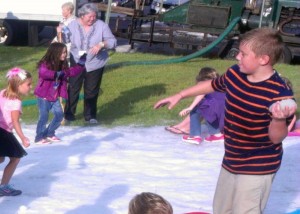By Doyice Cotten
 Recreational activities, sporting events, and injuries (read that lawsuits) go together sort of like love and marriage. For that reason, everyone who organizes such events should be aware of the following facts:
Recreational activities, sporting events, and injuries (read that lawsuits) go together sort of like love and marriage. For that reason, everyone who organizes such events should be aware of the following facts:
Fact 1 is accidents are apt to happen at any type of event or activity.
Fact 2 is not all accidents can be prevented.
Fact 3 is, however, that some accidents can be prevented and should have been prevented.
Fact 4 is that when Fact 3 occurs, someone (a supervisor, an organization, a sponsor) is often at fault – and a lawsuit is likely.
However, avoiding a lawsuit is not the most important lesson to be learned from these facts.
The real tragedy is that someone (a participant, a spectator, a child) is hurt needlessly. The injury may be minor – just a scraped knee, a bruise, or a headache. In that case, no real harm is done. However, what if the injury is a broken arm, a concussion, loss of vision in an eye, paralysis, or even death? Should the attitude of the person in charge be “Oh well, accidents will happen.”?
Most accidents occur because no one in charge foresaw that such a thing could happen. Of course, we can’t prevent all accidents (see Fact 2); in fact, we don’t even want to prevent all accidents because to remove all risk from most activities also removes the fun, the challenge, and whatever makes the activity enjoyable. Imagine removing all the risk from fishing – don’t go near the water, can’t use a hook, can’t catch a fish (sharp fins); well, you get the point.
Reducing the Risk
So what can we do? First, we must learn to look for and recognize risk. Some risk is acceptable – the risk of a trip and fall in a race; some risk is unacceptable – allowing a child to play catcher without a face mask. Recognizing risk comes partly from experience and partly from thoughtful consideration of what risk might be involved in an activity. One with limited experience might not recognize the risk associated with a race in which children run to touch a wall and return. After you see a child misjudge the distance and run into the wall, the risk becomes more obvious. Experience or not, if you just think in terms of risk when you observe an activity, you will begin to identify some and think “why don’t they change . . .?” If this becomes a habit, risks will seem to jump out at you.
Look at the way the activity is conducted. Should there be more rules? Look at the surroundings. Is the playing surface safe? Is the area free of obstructions? Is the area too crowded? Are the participants well matched in terms of size – or do you have 4-year-olds playing with 10-year-olds? Are dangerous implements (bats, golf clubs) being swung in a crowded area?
When you spot a possible risk, ask “How likely is it that this risk will come into play?” If there is little likelihood, you might be justified in ignoring it. However, you must also consider the consequences if it does come into play – might it result in an abrasion or bruise, or is it more likely to result in a concussion or the loss of an eye?
Adequate Supervision
The biggest factor in avoiding accidents is qualified, informed, and attentive supervisors of the activity. The supervisors should be qualified – this would include such factors as maturity, sometimes credentials (a pool lifeguard, for instance), training (including instructions regarding conduct that must not be allowed), and experience. The supervisors should be informed – they should have some understanding of the concepts of risk and risk management and the ability to foresee risks. The supervisors should be attentive – they must watch what is going on constantly; they should not be reading or distracted; and two or more supervisors should not be grouped together chatting.
A Real Life Example
Below are a number of photographs of Summer Snow Day at a church. It was a fun day for the youngsters playing in some “snow.” There were two play areas – one for the younger pre-school kids and one for everyone else. Some are “sledding” on floats, some are sliding, some throwing “snowballs,” and many just standing around. At the area for older kids there is one person supervising and some other adult observers who come and go. In light of the discussion above, how would you assess the risk management of the event?
Click to enlarge the photos and as you examine them carefully, identify the risks you see. Contrast the activity at the young children’s area with that of the older children. Consider what you, as the supervisor, would do to reduce those risks.
P.S. Believe it or not, to my knowledge, no one was injured. Makes me think of the old saying, “It’s better to be lucky than good.”






